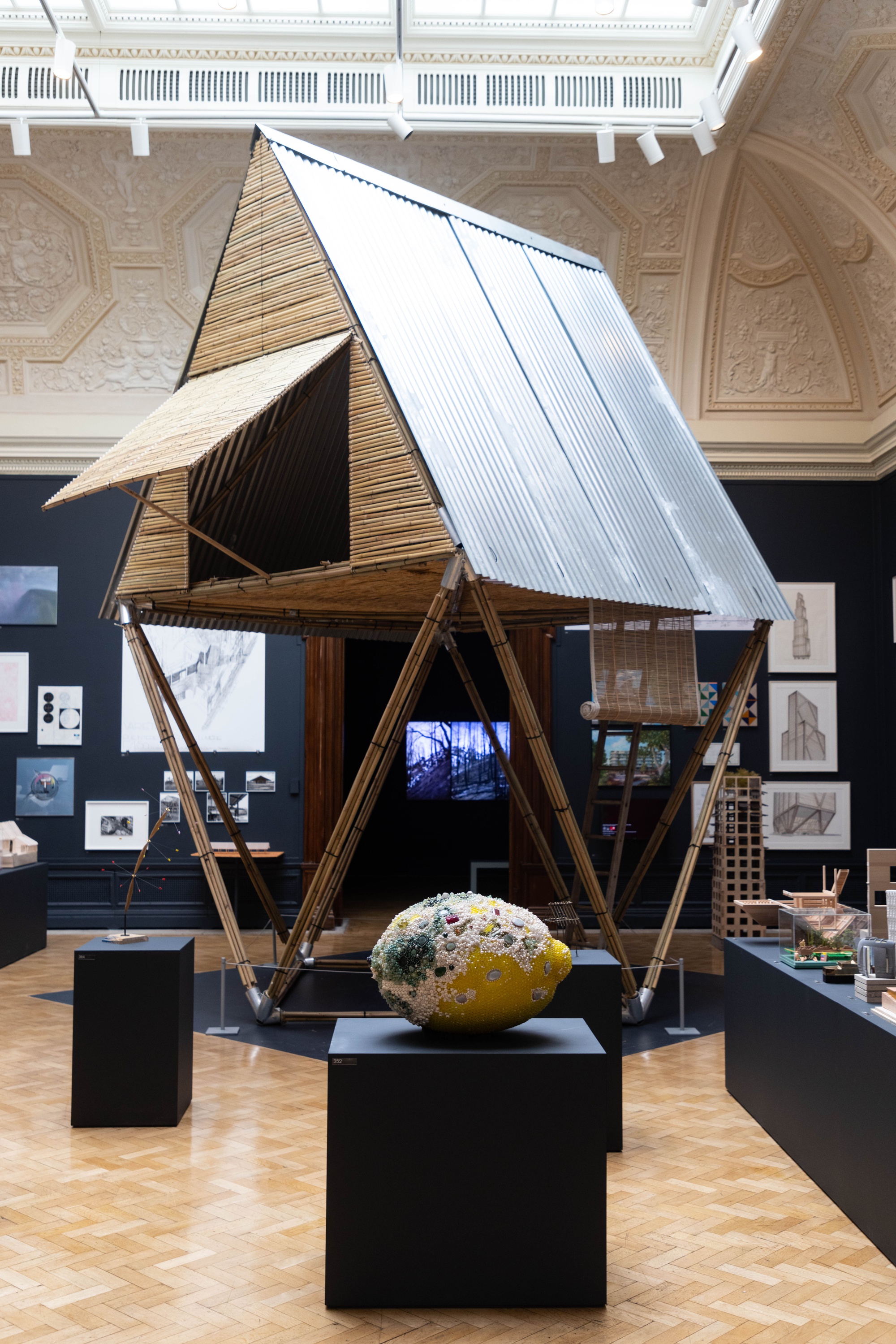RA Summer Exhibition - The Guardian
Text Olly Wainwright
Images David Parry/Royal Academy of Arts, Guy Bell, Oliver Wainwright
A gigantic stone beam greets visitors to the architecture rooms of this year’s Royal Academy Summer Exhibition, balancing precariously overhead like a neolithic seesaw. It is a fitting introduction, looming ominously above you like the climate crisis theme that haunts this year’s show.
While the climate topic could lead to a sense of apocalyptic despair and hopeless handwringing, the architecture rooms offer a few rays of hope. Architects and engineers have, after all, some responsibility for the mess we’re in, given that 40% of carbon emissions come from buildings. They also have the means to do something about it.
The big stone beam, made by the Stonemasonry Company and Webb Yates engineers, shows how structural stone can be used in place of concrete, saving massive amounts of carbon in the process. Assembled from blocks of Portland stone that had been rejected by the quarry for aesthetic blemishes, and great chunks of granite salvaged from a condemned postmodern building in the Docklands, it exploits the different properties of the two materials along the length of the beam, respectively working in tension and compression. It’s a beautiful and unnerving thing to behold. One false move and it might tip off balance and slice its way through the smeary Tracey Emin canvas on the wall.
“We wanted to offer a sense of hope,” says architect Niall McLaughlin, who curated the two rooms with artist Rana Begum. It is the first time the architecture section has been co-curated with an artist, and it’s much the better for it, mixing the work of artists and architects to break up the monotony. “There can be a sense of fatalism about the climate,” McLaughlin adds, “but our discipline can show that imaginative change is possible.”
The duo were keen to avoid the familiar sense of the architecture section as a separate enclave filled with little models and impenetrable drawings, so they decided to go big – really big – and commission several full-size structures for the first time. The star of the show is the Khudi Bari, or Tiny House, a modular monsoon-resistant shelter designed by Bangladeshi architect Marina Tabassum, which hovers above the other exhibits on slender bamboo legs, its ladder tempting you upwards to an elevated triangular cabin (sadly off-limits). Intended for inhabitants of the country’s capricious delta region, where strips of land can succumb to the powerful rivers overnight, the shelters are designed to be built by the residents themselves using local materials, for just £300. Avoiding the carbon miles of shipping materials, Tabassum sent detailed instructions for responsible local sourcing, while engineers AKTII reconfigured the structural supports to use bundles of thinner bamboo, the only kind available here.
In a poetic juxtaposition, her monsoon cabin towers over a delicate bronze model of an even more spindly shelter made of thin tree branches, by Takeshi Hayatsu. It is his interpretation of the Primitive Hut, the ultimate origin of architecture, as mythologised by 18th-century theorist Marc-Antoine Laugier, and it makes for a fitting counterpart, both speaking of the imperative to build with the bare minimum of means – and the elegant results that scarcity can spawn.
A third full-size installation uses waste materials quite literally, in the form of a structure made from elephant dung bricks, by Thai architect Boonserm Premthada. The teetering towers of compressed, dried pachyderm poo provide an arresting foil to the gallery’s ornate plaster friezes that ring the ceiling, evoking the warm, earthy texture of dung structures the architect has realised in Thailand. McLaughlin’s team was faced with an unusual challenge: Premthada’s recipe used Asian elephant dung, which has a more fibrous texture than the African elephant dung available from Colchester Zoo, but the results are impressively faithful to the original, despite the digestive differences. A final surreal touch to proceedings came on varnishing day (originally the day when artists would come in to varnish their paintings, but is now the exhibitors’ private view) when a team of Thai gilders turned up to apply squares of gold leaf to the towers of compacted crap, as crowds scoffed canapés around them. “The gold makes people respect what they would otherwise dismiss as waste,” says Premthada.
This being the RA, there are the usual obligatory contributions from the bloated corporate dinosaurs of the profession, proudly still showing off their glass and steel skyscrapers – with bolt-on “eco” features – that make for an amusing comparison with McLaughlin and Begum’s more thoughtful commissions. It also sets into sharp relief the most climate-friendly projects of them all: the ones that reuse and reinvent existing buildings. Refurbishment might not sound like the sexiest of things to exhibit, but the beguiling models and drawings of Catalan duo Ricardo Flores and Eva Prats – for their scheme to transform a derelict theatre in Brussels into a cultural laboratory – show how creative attitudes to retrofit can lead to results that are more layered, more complex and infinitely richer than bulldozing and starting from scratch.
